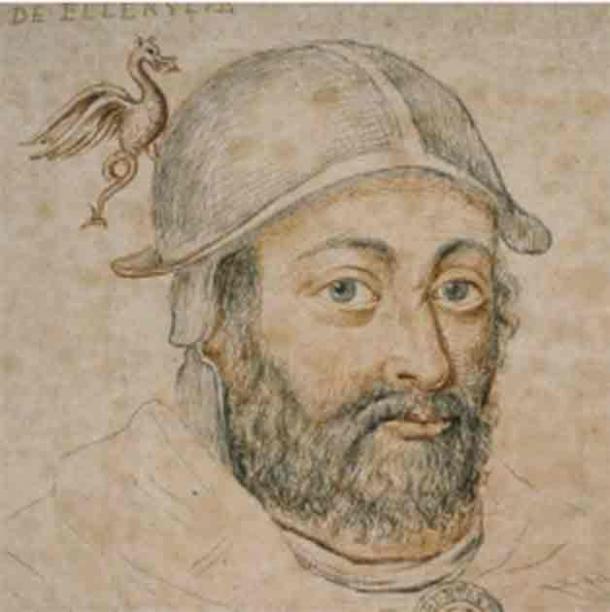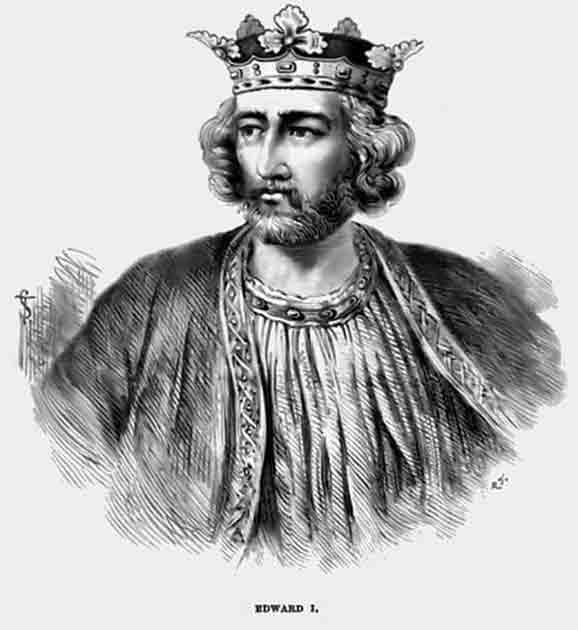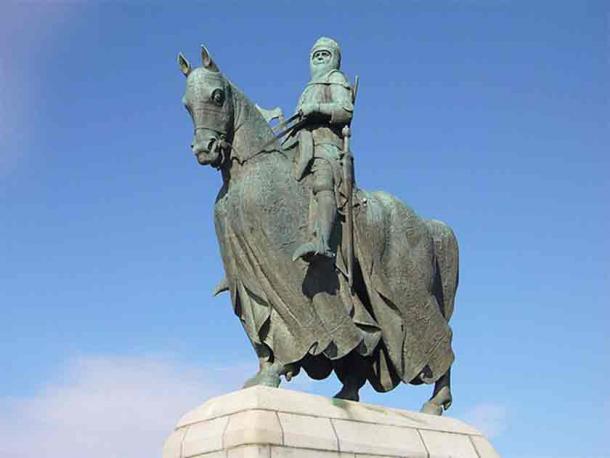
Beyond Braveheart – Revealing the Real William Wallace
Except for perhaps Robert the Bruce, William Wallace has to be the most famous figure in Scottish history. This legendary Scottish hero defied the odds and through his many clashes with the English left an undeniable mark on Scottish history. Born in the late 13th century, Wallace emerged as a key figure in the First War of Scottish Independence against English rule. His charismatic leadership and strategic prowess rallied the Scots, earning him a place in the annals of national pride and earning him his iconic “Braveheart” moniker. As with most heroes, however, over time the lines between fact and fiction have become blurred when it comes to Wallace. Let’s take a look at the life of the real William Wallace and what made him so great.
- Edinburgh Castle, Proud Custodian of Significant Scottish History
- The Untold True Story of Robert the Bruce, the Outlaw King

Sketch of William Wallace by David Erksine, 11th Earl of Buchan. (National Galleries of Scotland/ Public Domain)
William Wallace, Scotland’s Infamous National Hero
For such a historically influential figure little is known about Wallace’s family background. We know that he was born in 1270 AD into a family of land-owning lesser nobility but that’s about it. Sources differ as to who his parents were. According to Wallace’s seal, found on a letter dated 1297, his father was called Alan Wallace, whom little is known about. He may or may not have held Ellerslie, an estate near Kilmarnock, Ayrshire and this may or may not have been where Wallace was born.
It has been suggested that Wallace’s father was a knight, minor noble, and vassal of James Stewart, 5th High Steward of Scotland. This is somewhat of an assumption/ guess as the Wallace family in general were known to originate from lands that were within Stewart’s territory. The accolades Wallace received later in life also hint at a noble upbringing.
This general confusion can be attributed to two things. Firstly, poor record-keeping from the period makes accurately tracing Wallace’s family tree next to impossible. Secondly, Wallace’s later fame meant medieval scholars who wrote his posthumous biographies tended to be a little economical with the truth and heavily influenced by bias.
They tended to portray Wallace as having come from humble beginnings and these biographies tended to depict him as either a commoner or even a thief and outlaw. Scottish writers wanted to romanticize his origins and portray him as “one of us” while English scholars looked to villainize the rebel. To be fair, technically Wallace was an outlaw- his family never signed the 'Ragman Rolls' of 1296 which listed all the Scots who aligned themselves with the crown.
We also know extraordinarily little of Wallace’s private life. There is some evidence that he had two brothers, Malcolm, and John, but it is hard to verify. Likewise, as far as we know Wallace never married or had children, which was a little strange for the period. He was probably too busy fighting the English.
- A Spider Had a Leading Role in the Story of Scottish Independence
- Was the Wallace Sword Truly Wielded by the Famous Scottish ‘Braveheart’?

A 1906 depiction of William Wallace in H.E. Marshall’s ‘Scotland's Story.’ (Public Domain)
Edward I- Stirring Up Trouble
To understand William Wallace’s importance to Scottish history one first has to have a grasp of the state of Scotland at the time. In particular what Edward I of England was up to in the time leading up to Wallace’s military campaigns. After all, you can’t have a hero without a villain.
Depending on one’s perspective Edward I is either the villain or the hero of the story. He was famous for his fierce temper, self-confidence, and military acumen. At 1.9 meters tall, (6 ft 2 inches) he cut an imposing figure and was a battle-hardened military commander having already taken part in the ninth Crusade of 1271-1271. During his father’s reign, he had helped defeat rebel English barons who tried to overthrow his father and showed the Welsh a thing or two.

Edward I. (Willud Edier / Public Domain)
By 1287 Edward had set his sights on Scotland. That year he began expelling Jews from his kingdom, conveniently confiscating all their wealth and property in the process. What did he do with all this newfound wealth? He added it to his war chest and bid his time, waiting for the perfect opportunity to strike.
This opportunity came in the form of a Scottish succession crisis now known as the “Great Cause.” In 1286 King Alexander III of Scotland passed away. He was a respected leader whose reign had been a time of peace and economic stability for Scotland. Initially, he was succeeded by his granddaughter, Margaret the Maid of Norway.
Since she was just a child a government of guardians was set up to rule in her stead. It worked well enough until Margaret died in 1290 while traveling to Scotland. With no heir apparent chaos ensued as thirteen contenders vied for the Scottish throne.
This was Edward’s chance. He was asked to choose the best of the bunch but instead did the opposite. He chose the weak John Balliol who acted as Edward’s puppet. The Scottish nobles weren’t blind and began to ally themselves with Robert Bruce, grandfather of THE Robert the Bruce.
Edward then made things worse by increasing taxes on Scotland to pay for his campaigns in France. This made Edward even more unpopular and in 1295 Balliol betrayed his master and formally allied Scotland with France, the first step in forming the “Auld Alliance”. Edward’s revenge was swift and brutal.
In March 1296 Edward personally led his army to Berwick, Scotland. According to the 14th-century chronicler Walter of Guisborough he then slaughtered over 11,000 of the town's inhabitants. Allying himself with the Bruces he then fought at the Battle of Dunbar in April 1296, defeating Balliol, and stripping him of the Scottish crown.
In Balliol’s place, Edward put three loyal barons in power. He then took the symbol of the Scottish monarch, the Stone of Scone, and placed it in Westminster Abbey. Edward believed he had won but little did he know more rebellion was to come, led by William Wallace.
Wallace the Warrior
Wallace began making a name for himself as a thorn in England’s side in 1297. In May of that year, he led his first raid, attacking Lanark in Scotland. It was a massive success and the English sheriff of Lanark, William de Heselrig, was killed in the attack. Impressive considering Wallace had only had roughly 30 men.

Tom Church's statue "Freedom" near the Wallace Monument. (Bothar /CC BY-SA 3.0)
From there Wallace led winning raids on Scone (with the help of another rebel, William the Hardy) and several English military installations in Scotland between the rivers Forth and Tay. The raids were marked by Wallace’s use of what today would be called guerilla tactics, disappearing into the Scottish highlands after each attack and recouping at his base in Ettrick Forest.
These early successes have raised eyebrows among historians. According to legend Wallace had little to no military experience before 1297 so how could he be so successful? Some believe that prior to fighting for Scottish Independence Wallace likely fought as a mercenary for Edward I during his campaigns in Wales, helping to explain his military acumen and knowledge of English tactics.
The Battle of Stirling Bridge
These early raids were just the starters. The main course was the du on 11 September 1297. Wallace teamed up with Sir Andrew Moray of Bothwell (who had been leading his own rebellion in the north of Scotland) and between them, the two men mustered up a massive Scottish force.
This force then clashed with the English army, which was led by John de Warenne, Earl of Surrey, and came equipped with at least 300 deadly heavy cavalry. Using both his larger numbers and superior tactics Wallace was victorious. The Scots flanked the English troops and trapped them on a bridge. They then slaughtered at least 100 English knights, the most high-profile of which was Sir Hugh de Cressingham, Edward’s treasurer.

Drawing of the Battle of Stirling Bridge. (Public Domain)
This victory gave Wallace the boost he needed to take the fight to the English. That year he raided Northern England attacking the counties of Northumberland and Cumberland and besieging Alnwick and Carlisle Castles. Things were going so well that he and his buddy Moray wrote letters to prominent European traders saying it was safe to resume trade with Scotland.
The following year Wallace was made a knight, probably by Robert the Bruce (who would soon be King of Scotland). In recognition of his success, Wallace was also made a “Guardian” of the Scottish government and commander-in-chief. Braveheart was born.
The Beginning of the End
Just as things looked brightest for Wallace the tides began to change. In 1298 Edward I once again personally led his army into Scotland. Wallace, up to his old tactics, retreated ever northward, destroying everything in his wake as he went. He hoped doing so would lure Edward’s army further into Scotland and deprive them of supplies.
Unfortunately for Wallace things didn’t go to plan. The Scottish and English armies finally clashed at the Battle of Falkirk on 22 July 1298, but things didn’t go Wallace’s way. Edward attacked the Scots on two sides, making clever use of his dread longbow archers and skilled English cavalry. The Scottish cavalry panicked and retreated, leaving the Scottish spearmen to be picked off by English bow fire.
It was a decisive English victory. It’s believed around 20,000 Scots were killed compared to only 2,000 Englishmen. Wallace survived the bloodshed but shamed by his defeat resigned as Guardian of Scotland. It was the beginning of the end for Scotland’s favorite hero.

Selkirk’s Auld Kirk, where archaeologists say that William Wallace was declared Guardian of Scotland in 1297. (James Denham/CC BY-SA 2.0)
Wallace Disappears- The Ruling Council
What happened next is a little murky. At the time of Wallace’s defeat at Falkirk Scotland had no king. Instead, it was under the control of the ruling council led by Wallace, John Comyn, and Bishop Lamberton. Initially, the Bruces, historic enemies of the Comyns, refused to have anything to do with the council but after Falkirk joined the council. Around this time Wallace seems to have left the council while the Comyns and Bruces ran it together.

Robert the Bruce statue, Bannockburn notwithstanding William Wallace's popularity. (kim traynor /CC BY-SA 2.0)
The next few years saw the Bruces playing both sides. First, they helped in the attack on English-held Ayr Castle but then confused things in 1302 when Robert married Elizabeth, whose family was allied to Edward. When Balliol was released from the Tower of London Robert the Bruce allied himself with the English, hoping to prevent the ex-king Balliol from retaking the Scottish throne. Bruce wanted that for himself.
During all of this Edward continued his attacks on Scotland, leading more successful campaigns in 1300, 1301, and 1303. The Scottish nobility had learned it was best to avoid Edward’s army and let him take what he wanted. Edward was getting long in the tooth and his days were running out. Once he was gone the Scots could retake what they’d lost.
Where was Wallace during all of this? No one really knows. Between the Falkirk disaster and 1305, he seems to have pretty much disappeared. Some sources describe him fighting in the Highlands as a guerilla while others say he escaped to France with the aid of a pirate. There he is said to have pleaded for French military and financial aid in the hopes of returning to Scotland and finally defeating the English.
Wallace’s Fall
Whatever the truth, Wallace remained a free man until 1305. Some sources state he was betrayed by friends and handed over to the English while others say on 5 August John de Meteith, a Scottish knight, caught Wallace and turned him over at Robroyston, near Glasgow. Rather damningly, Wallace was said to be carrying letters of safe conduct from Haakon V of Norway, Philip IV of France, and John Balliol. All of Edward’s enemies, basically.
From there Wallace was swiftly taken to London and marched into Westminster Hall (wearing a crown of oak leaves according to some accounts). Once there he was charged with treason and trying to ally Scotland with England’s old nemesis, France. To make things worse he was also charged with committing atrocities against civilians during his raids. Interestingly, some historians believe this makes Wallace one of the first people in history to be tried for war crimes, which isn’t the best claim to fame.

‘The Trial of William Wallace at Westminster’ (pre-1870) by Daniel Maclise. (Public Domain)
Wallace tried to argue that since he had never sworn allegiance to Edward he couldn’t be tried for treason. The only king he recognized was the currently de-throned Balliol. Unsurprisingly, the court had none of it and happily found Wallace guilty on all counts. They decided to make an example of the rebellious Scotsman.
On 23 August 1305 Wallace was taken to the Tower of London where he was stripped naked. He was then dragged through London’s streets by horse to the Elms at Smithfield. Once there he was hanged until nearly dead but then released. While still clinging on to life he was put on a bench and emasculated (his penis and testicles were removed). Next, his intestines were pulled from his body and burned in front of him. Finally, he was beheaded and cut into four pieces.
If this gruesome execution didn’t send a message, the next part definitely did. Wallace’s head was put on a spike on London Bridge while his body parts were displayed in Newcastle, Berwick, Stirling, and Perth.
Conclusion
It was an ignoble end for one of Scotland’s greatest heroes. However, the English had made a mistake. By humiliating the hero, they only spurred on the Scots to deify the man and he became a national hero who represented Scotland’s fight against its historic oppressors.
As time went on historical fact and legend intertwined until the lines became blurred. This means it can be difficult for modern historians to really, impartially write a history of William Wallace. In more recent times this confusion has also given rise to entertaining but historically dubious works like 1995’s Braveheart.
Confusion, unreliable sources, and personal biases aside Wallace’s contributions to Scottish independence can’t be denied. He is rightly recognized as a national hero who fought and ultimately died for what he believed in. In humiliating such a man the English not only made him a legend, but they also made sure that Scotland’s fight for independence had a martyr.
Top image: Statue of William Wallace at Aberdeen. Source: Public Domain
References
Cartwright. M. 2021. William Wallace. Available at: https://www.worldhistory.org/William_Wallace/
Editors. 2024. William Wallace. Available at: https://www.britannica.com/biography/William-Wallace
Fraga. K. 2022. How The English Exacted Their Bloody Revenge On Scottish Rebel William Wallace. Available at: https://allthatsinteresting.com/william-wallace-death















